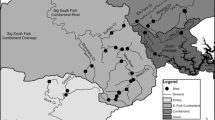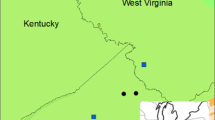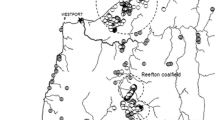Abstract
Recent studies have documented adverse effects to biological communities downstream of mountaintop coal mining and valley fills (VF), but few data exist on the longevity of these impacts. We sampled 15 headwater streams with VFs reclaimed 11–33 years prior to 2011 and sampled seven local reference sites that had no VFs. We collected chemical, habitat, and benthic macroinvertebrate data in April 2011; additional chemical samples were collected in September 2011. To assess ecological condition, we compared VF and reference abiotic and biotic data using: (1) ordination to detect multivariate differences, (2) benthic indices (a multimetric index and an observed/expected predictive model) calibrated to state reference conditions to detect impairment, and (3) correlation and regression analysis to detect relationships between biotic and abiotic data. Although VF sites had good instream habitat, nearly 90 % of these streams exhibited biological impairment. VF sites with higher index scores were co-located near unaffected tributaries; we suggest that these tributaries were sources of sensitive taxa as drifting colonists. There were clear losses of expected taxa across most VF sites and two functional feeding groups (% scrapers and %shredders) were significantly altered. Percent VF and forested area were related to biological quality but varied more than individual ions and specific conductance. Within the subset of VF sites, other descriptors (e.g., VF age, site distance from VF, the presence of impoundments, % forest) had no detectable relationships with biological condition. Although these VFs were constructed pursuant to permits and regulatory programs that have as their stated goals that (1) mined land be reclaimed and restored to its original use or a use of higher value, and (2) mining does not cause or contribute to violations of water quality standards, we found sustained ecological damage in headwaters streams draining VFs long after reclamation was completed.






Similar content being viewed by others
References
Agouridis CT, Angel PN, Taylor TJ, Barton CD, Warner RC, Yu X, Wood C (2012) Water quality characteristics of discharge from reforested loose-dumped mine spoil in eastern Kentucky. J Environ Qual 41:454–468
Baker ME, King RS (2010) A new method for detecting and interpreting biodiversity and ecological community thresholds. Method Ecol Evol 1:25–37
Barbour MT, Gerritsen J, Snyder BD, Stribling JB (1999) Rapid bioassessment protocols for use in streams and wadeable rivers: periphyton, benthic macroinvertebrates, and fish, 2nd edition. EPA 841-B-99-002. Washington, DC: U.S. Environmental Protection Agency, Office of Water
Bernhardt ES, Palmer MA (2011) The environmental costs of mountaintop mining valley fill operations for aquatic ecosystems of the central Appalachians. Ann N Y Acad Sci 1223:39–57
Bernhardt ES, Lutz BD, King RS, Fay JP, Carter CE, Helton AM, Campagna D, Amos J (2012) How many mountains can we mine? Assessing the regional degradation of Central Appalachian rivers by surface coal mining. Environ Sci Technol 46(15):8115–8122
Cormier SM, Suter GW, Zhieng L, Pond GJ (2013a) Assessing causation of the extirpation of stream macroinvertebrates by a mixture of ions. Environ Toxicol Chem 32:277–287
Cormier SM, Wilkes SP, Zheng L (2013b) Relationship of land use and elevated ionic strength in Appalachian watersheds. Environ Toxicol Chem 32:296–303
Cummins, KW (1988) Rapid bioassessment using functional analysis of running water invertebrates. In Simon TP, Holst LL & Shepard LJ (eds), Proceedings of the First National Workshop on Biological Criteria. EPA-905/9-89/003. U.S. Environmental Protection Agency, Chicago, pp. 49–54
U.S. EPA (2005) Mountaintop mining/valley fills in Appalachia. Final programmatic environmental impact statement. Philadelphia, PA: U.S. Environmental Protection Agency, Region 3. Available from: http://www.epa.gov/region03/mtntop/eis2005.htm
U.S. EPA (2011a) The effects of mountain top removal and valley fill mining on aquatic ecosystems of the Central Appalachian Coal Basin. National Center for Environmental Assessment, Washington, DC; EPA/600/R-02/056F. Available from: http://cfpub.epa.gov/ncea/cfm/recordisplay.cfm?deid=225743
U.S. EPA (2011b) A field-based aquatic life benchmark for conductivity in Central Appalachian streams. U.S. Environmental Protection Agency, NCEA, Washington, DC (2011), EPA/600/R-10/023A. Available from: http://cfpub.epa.gov/ncea/cfm/recordisplay.cfm?deid=233809
ESRI (2011) ArcGIS Desktop: Release 10. Environmental Systems Research Institute, Redlands
Fritz KM, Fulton S, Johnson BR, Barton CD, Jack JD, Word DA, Burke RA (2010) Structural and functional characteristics of natural and constructed channels draining a reclaimed mountaintop removal and valley fill coal mine. J N Am Benthol Soc 29(2):673–689
Fry JA, Xian G, Jin S, Dewitz JA, Homer CG, Yang L, Barnes CA, Herold ND, Wickham JD (2011) Completion of the 2006 National Land Cover Database for the Conterminous United States. Photogramm Eng Remote Sens 77:858–864
Gerritsen, J, Zheng L, Burton J, Boschen C, Wilkes S, Ludwig, J, Cormier, S. (2010) Inferring causes of biological impairment in the Clear Fork Watershed, West Virginia. U.S. Environmental Protection Agency, Office of Research and Development, National Center for Environmental Assessment, Cincinnati. EPA/600/R-08/146
Gore JA, Milner AM (1990) Island biogeographical theory: can it be used to predict lotic recovery rates? Environ Manag 14:737–753
Griffith MB, Norton SB, Alexander LC, Pollard AL, LeDuc SD (2012) The effects of mountaintop mines and valley fills on the physicochemical quality of stream ecosystems in the Central Appalachians: a review. Sci Total Environ 417–418:1–12
Hartman KJ, Kaller MD, Howell JW, Sweka JA (2005) How much do valley fills influence headwater streams? Hydrobiologia 532:91–102
Johnson BR, Haas A, Fritz KM (2010) Use of spatially explicit physicochemical data to measure downstream impacts of headwater stream disturbance. Water Resour Res 46:W09526
Kefford BJ, Schäfer RB, Liess M, Goonan P, Metzeling L, Nugegoda D (2010) A similarity-index-based method to estimate chemical concentration limits protective for ecological communities. Environ Toxicol Chem 29:2123–2131
Kunz JL, Conley JM, Buchwalter DB, Norberg-King TJ, Kemble NE, Wang N, Ingersoll CG (2013) Use of reconstituted waters to evaluate effects of elevated major ions associated with mountaintop coal mining on freshwater invertebrates. Environ Toxicol Chem 32:1–10
Langford TEL, Shaw PJ, Ferguson AJD, Howard SR (2009) Long-term recovery of macroinvertebrate biota in grossly polluted streams: re-colonisation as a constant to ecological quality. Ecol Ind 9:1064–1077
Ligeiro R, Ferreira W, Hughes RM, Callisto M (2013) The problem of using fixed-area subsampling methods to estimate macroinvertebrate richness: a case study with Neotropical stream data. Environ Monit Assess 85:4077–4085
Lindberg TT, Bernhardt ES, Bier RA, Helton M, Merola RB, Vengosh A, Di Giulio RT (2011) Cumulative impacts of mountaintop mining on an Appalachian watershed. Proc Natl Acad Sci 108:20929–20934
McCune B, Grace JB (2002) Analysis of ecological communities. MjM Software Design, Gleneden Beach
Merriam ER, Petty JT, Merovich GT, Fulton JB, Strager MP (2011) Additive effects of mining and residential development on stream conditions in a central Appalachian watershed. J N Am Benthol Soc 30:399–418
Palmer MA, Bernhardt ES, Schlesinger WH, Eshleman KN, Foufoula-Georgiou E, Hendryx MS (2010) Mountaintop mining consequences. Science 327(5962):148–149
Parkyn SP, Smith BJ (2011) Dispersal constraints for stream invertebrates: setting realistic timescales for biodiversity restoration. Environ Manag 48:602–614
Paybins KS (2003) Flow origin, drainage area, and hydrologic characteristics for headwater streams in the mountaintop coal-mining region of southern West Virginia. Water Resources Investigation Report 02-4300. USGS, Charleston
Peterson MJ, Efroymson RA, Adams SM (2011) Long-term biological monitoring of an impaired stream: synthesis and environmental management implications. Environ Manag 47:1125–1140
Pond GJ (2010) Patterns of Ephemeroptera taxa loss in Appalachian headwater streams (Kentucky, USA). Hydrobiologia 641(1):185–201
Pond GJ (2012) Biodiversity loss in Appalachian headwater streams (Kentucky, USA): Plecoptera and Trichoptera communities. Hydrobiologia 679(1):97–117
Pond GJ, North SH (2013) Application of a benthic observed/expected model for assessing Central Appalachian streams influenced by regional stressors in West Virginia and Kentucky. Environ Monit Assess 185:9299–9320
Pond GJ, Passmore ME, Borsuk FA, Reynolds L, Rose CA (2008) Downstream effects of mountaintop coal mining: comparing biological conditions using family- and genus-level macroinvertebrate bioassessment tools. J N Am Benthol Soc 27(3):717–737
Pond GJ, Bailey JE, Lowman BM, Whitman MJ (2012) Calibration and validation of a regionally and seasonally stratified macroinvertebrate index for West Virginia wadeable streams. Environ Monit Assess 185:1515–1540
Rikard M, Kunkle S (1990) Sulfate and conductivity as field indicators for detecting coal-mining pollution. Environ Monit Assess 15:49–58
Smith RF, Lamp WO (2008) Comparison of insect communities between adjacent headwater and main-stem streams in urban and rural watersheds. J N Am Benthol Soc 27:161–175
Suter GW, Cormier SM (2013) A method for assessing the potential for confounding applied to ionic strength in Central Appalachian streams. Environ Toxicol Chem 32:288–295
Wickham J, Wood P, Nicholson MC, Jenkins W, Druckenbrod D, Suter GW, Stager MP, Mazzerella C, Galloway W, Amos J (2013) The overlooked terrestrial impacts of mountaintop mining. Bioscience 63:335–348
Wipfli MS, Richardson JS, Naiman RJ (2007) Ecological linkages between headwaters and downstream ecosystems: transport of organic matter, invertebrates, and wood down headwater channels. J Am Water Resour Assoc 43:72–85
Wood PB, Williams JM (2013) Impact of valley fills on streamside salamanders in southern West Virginia. J Herpetol 47:119–125
Woods AJ, Omernik JM, Brown DD, Kiilsgaard CW (1996) Level III and IV Ecoregions of Pennsylvania and the Blue Ridge Mountains, the Ridge and Valley, and the Central Appalachians of Virginia, West Virginia, and Maryland. EPA/600R-96/077. USEPA, ORD, Corvallis
Woods AJ, Omernik JM, Martin WH, Pond GJ, Andrews WM, Call SM, Comstock JA, Taylor DD (2002) Ecoregions of Kentucky (2 sided color poster with map, descriptive text, summary tables, and photographs): Reston, Va., US Geological Survey (map scale 1:1,000,000)
WVDEP (2010a) Trends in mining fills and associated stream loss in West Virginia 1984-2009. West Virginia Department of Environmental Protection, Technical Applications and GIS Unit, Charleston, WV. Available from: http://tagis.dep.wv.gov/tagis/projects/Mining_Fill_trends_in_West_Virginia_1984-2009.pdf
WVDEP (2010b) West Virginia integrated water quality monitoring and assessment report. West Virginia Department of Environmental Protection, Division of Water and Waste Management. Charleston, WV. Available from: http://www.dep.wv.gov/WWE/watershed/IR/Documents/IR_2010_Documents/2010IR_EPA_Approved_Full_Version.pdf
WVDEP (2011) Watershed Branch 2011 Standard Operating Procedures. West Virginia Department of Environmental Protection, Division of Water and Waste Management, Watershed Assessment Branch. Charleston, WV. Available from: http://www.dep.wv.gov/WWE/watershed/Pages/WBSOPs.aspx
Zipper CE, Burger JA, Skousen JG, Angel PA, Barton CD, Davis V, Franklin JA (2011) Restoring forests and associated ecosystem services on Appalachian coal surface mines. Environ Manag 47:751–765
Acknowledgments
This research was performed jointly through cooperation between U.S. Environmental Protection Agency (EPA) Region III and U.S. Department of Interior’s Office of Surface Mining Reclamation and Enforcement (OSMRE)and we thank John Pomponio and John Forren (EPA-Region III) and Lois Uranowski and Dave Hartos (OSMRE) for programmatic support to the authors. Additional field assistance was provided by Lou Reynolds (EPA- Region III) and Omar Beckford (OSMRE). We especially appreciate mining inspectors from WVDEP’s Logan, Oak Hill, and Philippi Offices who assisted with site access, and Nick Schaer (WVDEP) for advice on site selection. We also thank Tom Mastrorocco (OSMRE) for GIS assistance. An earlier draft of the manuscript was reviewed by Ken Fritz, Brent Johnson, and Glenn Suter (EPA-Office of Research and Development), Matt Klasen and Rachael Novak (EPA-Office of Water), Jeff Bailey and Michael Whitman (WVDEP), Stefania Shamet (EPA-Region III), Leah Ettema (EPA-Region IV) and Jason Robinson (Illinois Natural History Survey). We also thank Angus Webb (University of Melbourne) and Kyle Hartman (West Virginia University) for thier reviews. Although this research was supported by EPA and OSMRE, opinions are those of the authors and do not represent official government policy.
Author information
Authors and Affiliations
Corresponding author
Electronic supplementary material
Below is the link to the electronic supplementary material.
Rights and permissions
About this article
Cite this article
Pond, G.J., Passmore, M.E., Pointon, N.D. et al. Long-Term Impacts on Macroinvertebrates Downstream of Reclaimed Mountaintop Mining Valley Fills in Central Appalachia. Environmental Management 54, 919–933 (2014). https://doi.org/10.1007/s00267-014-0319-6
Received:
Accepted:
Published:
Issue Date:
DOI: https://doi.org/10.1007/s00267-014-0319-6




